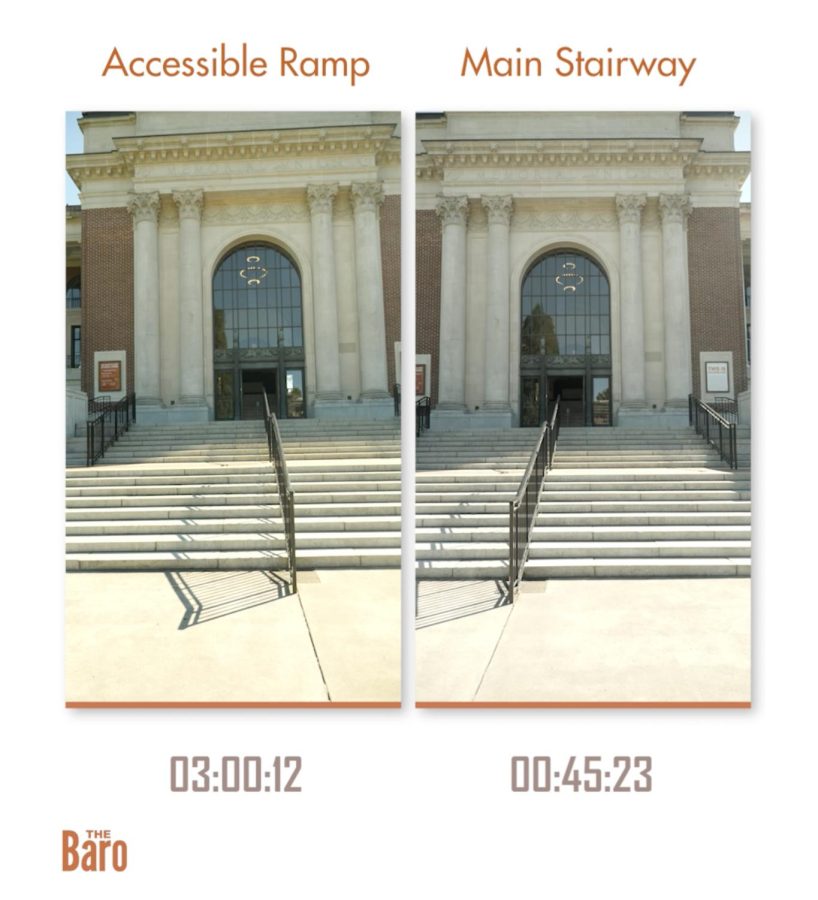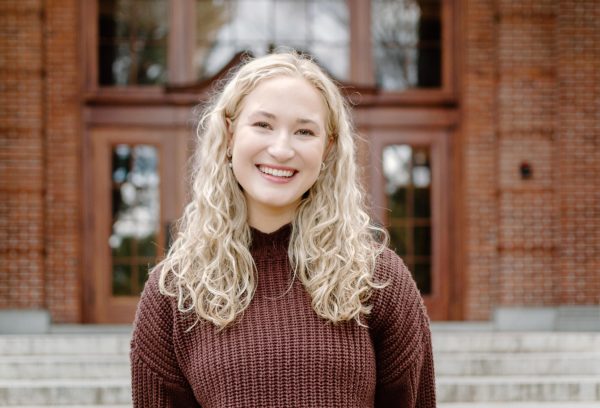The Sunny Side: Accessibility for wheelchairs on campus is not inclusive
Side by side comparisons of the time needed for someone who is able bodied (right) and someone using a wheelchair to enter the Memorial Union on Oregon State University’s Corvallis campus.
AnnMarie Bottita, Creative Video Associate
November 3, 2022
Editor’s Note: This column does not represent the opinion of The Daily Barometer. This column reflects the personal opinions of the writer.
“Everyone is welcome,” says the banner as you enter the Valley Library on the Oregon State University campus. But does everyone feel included?
When it comes to accessibility for wheelchair users, it’s important that it’s as much an accessible environment as it is inclusive. If certain walkways, buildings, desks and more are not accessible and embracing, then some of our Beavers are being left out — and that’s what is happening. I believe we need to make a more inclusive space for wheelchair accessibility on campus by working with the students.
What if it isn’t easy to access a building because you’re in a wheelchair? What if you feel secluded or stressed because you can’t acquire the support you need to be included?
For Disabled Students Union President, Cameo Ariel Ku’ualohalani Perrells, it’s a normal day in the life. She doesn’t stay silent, but instead leads DSU with a powerful voice from her perspective.
“Most of the time the designated wheelchair space leaves me segregated from other students and I am not able to interact with them,” Perrells said.
College is already tough as it is, and Perrells is secluded from the rest of her class.
“The accessibility for wheelchairs on campus needs improvement,” Perrells said. “The biggest difficulty as a disabled student who uses a wheelchair for mobility is ableism and stigma. OSU prides itself on inclusion and diversity but treats students with disabilities as an Americans with Disabilities Act liability, our preferences are often disregarded and we are reduced to second-class citizen treatment having to barter, beg and settle for accommodations.”
The departments have plans of their own. The renovation of ‘Community Slope,’ Furman and Pharmacy, provided more accessible environments.
“We intend to continue with two more phases to improve areas south of Jefferson around Kerr and Snell as well as north improving pathways and parking around Community Hall, the Hattie Redmond Women and Gender Center, all the way up to Campus Way,” said Gabe Merrell, director of Access and Affirmative Action and deputy ADA coordinator for the office of Equal Opportunity and Access.
The Valley Library’s accessibility currently consists of automatic doors, single user restrooms on three floors with automatic opening doors and locks and ADA stalls.
“Of course, we always want to make sure we have clear walkways. Part of my job is we do regularly check the building because furniture moves,” said Lucinda Amerman, administrative program specialist for the Valley Library.
“We are gradually replacing the locks on our study room doors,”Amerman said. “We just had a proposal approved to get some ADA lockers. And so we’re going to be putting those on floors 1, 2 and 3. But that’s the very early stages. We’ve written the proposal, we’ve got the funding approved. And so now we’re starting to do the planning.”
Inclusion is recognized in the accessibility departments, and there is a passion to positively change. The departments do strive to provide an inclusive environment for all.
“I often tell folks I wear two hats when I’m brought into a conversation,” Merrell said. “One hat is the compliance hat — what do we have to do in any particular situation, the other hat is an inclusion hat — what should we do in any particular situation. Those two answers can vary greatly…compliance is important, but it is also a floor: we can decide what our values are above and beyond what is required of us.”
Perrells has new ideas to improve accessibility, such as hiring a team of disabled professionals and consultants for projects.
“It would be helpful if DAS and other resource departments were staffed with more faculty who are allies to our community,” Perrells said.
For the Valley Library, the furniture could be limited in study rooms to better accommodate a wheelchair.
“This could be a standard for smaller rooms,” Perrells said.
Starship robot delivery is even an issue that many don’t consider.
“The sidewalks are already narrow enough and these robots take up the majority of the space. A wheelchair user cannot simply go around most of the time due to grass or a curb dropoff. They were practical during the quarantine but they’re not needed, especially now that we have gone back to pre-covid population on campus,” Perrells said.
Returning to Merrell and Amerman, their department’s ADA cooperation is evident, but it’s also apparent the plans are slow moving with a dash of “hope.” So, why are these designs so sluggish and not inclusive?
There are two easy answers: money and communication.
“Everyone that works on or has responsibilities for the physical facilities at OSU has the desire to make the campus a model for accessibility,” Merrell said. “The challenge is in getting enough resources to make it happen.”
Although automatic door openers are not required in the 2010 ADA standards, since 2010 over 359 have been installed throughout the OSU campus.
“This is an example of how, with limited funding and space to move, the administration tries their best to alter the accessibility for wheelchair users in the best way possible,” Merrell said.
Nevertheless, money is always an issue. I believe to connect the disconnect, we need to build roads to drive what the students need through to the side of the administration.
Reaching out and listening to students who live these policies every day of their lives, including them in the planning and decision-making processes is the most important step because they know how to make OSU a place Beavers can call home.
Back to the banner in the Valley Library, the answer to truly believing that “everyone is welcome” means communicating with everyone, especially leaders like Perrells, to ensure an embracing environment for all our Beavers.


















































































![Newspaper clipping from February 25, 1970 in the Daily Barometer showing an article written by Bob Allen, past Barometer Editor. This article was written to spotlight both the student body’s lack of participation with student government at the time in conjunction with their class representatives response. [It’s important to note ASOSU was not structured identically to today’s standards, likely having a president on behalf of each class work together as one entity as opposed to one president representing all classes.]](https://dailybaro.orangemedianetwork.com/wp-content/uploads/2025/03/Screenshot-2025-03-12-1.00.42-PM-e1741811160853.png)

























